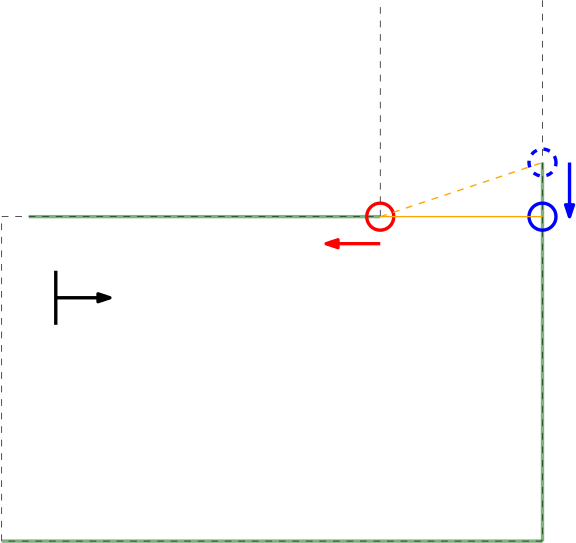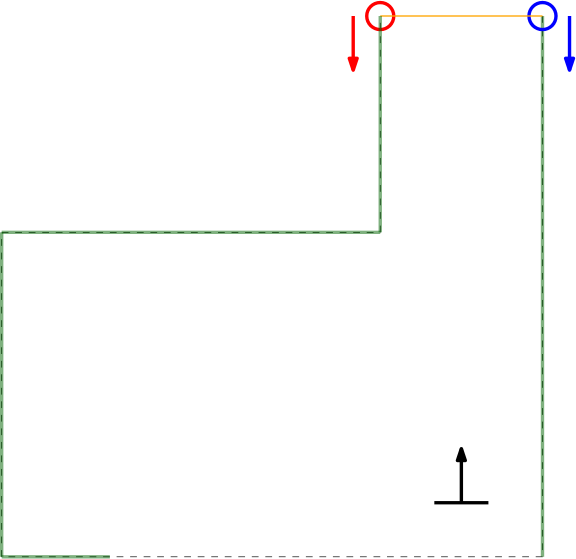Embedded Motion Control 2019 Group 7: Difference between revisions
| Line 59: | Line 59: | ||
* 0 data points found | * 0 data points found | ||
''Protocol 1'' | |||
If no data points are found, PICO should turn until it finds at least two data points. If not move to protocol 2. | If no data points are found, PICO should turn until it finds at least two data points. If not move to protocol 2. | ||
''Protocol 2'' | |||
If after a full turn not data points were found, apparently no gaps are in range. PICO should move forward in a safe direction untill it either cannot move anymore, a maximum distance is reached, or data points are detected. If none are detected, return to protocol 1. | If after a full turn not data points were found, apparently no gaps are in range. PICO should move forward in a safe direction untill it either cannot move anymore, a maximum distance is reached, or data points are detected. If none are detected, return to protocol 1. | ||
Revision as of 10:02, 8 May 2019
Group members
- Guus Bauwens - 0958439
- Ruben Beumer - 0967254
- Ainse Kokkelmans - 0957735
- Johan Kon - 0959920
- Koen de Vos - 0955647
Introduction
This wiki page describes the design process for the software as applied to the PICO robot within the context of the "Embedded Motion Control" course project. The project is comprised of two challenges: the escape room challenge and the hospital challenge. The goal of the escape room challenge is to exit the room autonomously as fast as possible. The goal of the hospital challenge is to autonomously visit an unknown number of cabinets as fast as possible.
Design Document
The design document, describing the initial design requirements, functions, components, specifications and interfaces, can be found here.
Requirements
Functions
Components
Specifications
Interfaces
Challenge 1: The escape room
As an intermediate assignment, the PICO robot should autonomously escape a room through a door from any arbitrary initial position as fast as possible.
To complete this goal, the following steps are introduced:
- The sensors and actuator are initialized.
- From the initial position, the surroundings are scanned for gaps between the walls. If no openings are found, the robot is to rotate until the opening is within view.
- The robot will drive towards a subtarget, placed at a small distance from the opening in order to avoid wall collisions.
- Once arrived at the subtarget, the robot will rotate towards the target.
- After being aligned with the target, the robot will drive straight trough the corridor.
To this end, methods for the detection of gaps between walls, the placement of (sub)targets and the path planning are required.
Gap detection
From the initial position, the surroundings are scanned using a Laser Range Finder (LFR). A gap is detected when there is a significant jump (of more than 0.4 [m]) between two subsequent data points. This method is chosen for its simplicity, it does not require any mapping or detection memory.
Within the context of the escape room challenge, either a one (from within the escape room) or two gaps (in front of or in the corridor) can be detected, as depicted in Figures \ref{} and \ref{}.
As can be seen in these Figures, dependent on PICO's orientation, gaps can be detected under an angle resulting in a false recognition of the corridor entry. To this end, the gap size is minimized by moving the points on the left and right side of the gap respectivily counterclockwise and clockwise. The result of this data processing is shown in the Figure \ref{} where the dotted orange line depicts the initial gap, and the straight orange line depicts the final gap. Here, the left (red) point is already optimal and the right (blue) point is optimized.
In this example of a possible situation, PICO is located straight in front of the corridor. In this case the gap cannot be optimized in the same way because moving either of the points increases the distance between the points (as they are not iterated at the same time). In Section xxx the script is expanded to deal with this scenario.
Dealing With Boundery Scenarios
Initially 2 detected data points are be expected, 1 of each corner of the exit. This would be the case if the escape rooms exit would have empty space behind it. Topology wise this is true, but in practice the LRF will possibly detect the back wall of the room the escaperoom is placed in or other obstructions standing around the exit.
In the case a (more or less solid) backwall is detected, the gap finder will find 2 gaps, one on each side of the exit. In this case point 1 and 4 are taken to determine the target. The target is defined as the midpoint between data points 1 and 4 and the subtarget is once again interpolated into the maze.
(Sub)Target Placement
As driving straight to the midpoint of an detected gap, will result in a collission with a wall in some circumstances, a subtarget is created. The target is interpolated into the escape room to a fixed distance perpendicular to the gap. This point is first targeted. PICO will turn that it is facing this point and will drive in a straight line to reach it. When PICO is approaching the subtarget, the corridor will become visible. As this removes the discontinuity in the data (as PICO can now see into the corridor), a new target is found consisting out of either 2 or 4 points. In the first case no backwall is detected, in the second case a back wall is detected. In this scenario two gaps will be found; to the left and to the right of the end of the exit. The new target will become the middle of the 1st and 4th point. A subtarget is possible, but will not change PICO's desired direction.
Path Planning
The loop of finding gaps is gone through continuously. The following cases are build in:
- 0 data points found
Protocol 1 If no data points are found, PICO should turn until it finds at least two data points. If not move to protocol 2.
Protocol 2 If after a full turn not data points were found, apparently no gaps are in range. PICO should move forward in a safe direction untill it either cannot move anymore, a maximum distance is reached, or data points are detected. If none are detected, return to protocol 1.
- 2 data points found
The 2 points are interpolated as target, the subtarget is interpolated. PICO should allign itself with the subtarget and move straight towards it.
- 4 data points found
Point 1 and 4 are interpolated as target, the subtarget is interpolated. PICO should allign itself with the subtarget and move straight towards it.
- > 4 datapoints found
In theory this should not happen. If so PICO should move forwards if this is safe to do so.
Dealing with discontinuities in walls
If a wall is not placed perfect, the LRF could find an obstruction behind the wall and indicate it as a gap (as the distance between the escape rooms wall and the obstruction will be bigger than the minimum value of a gap), while in practice the gap is way to small to fit through. These false positives should be filtered.
In the Figure to the right the algorithm used is presented. 4 points are detected as 2 jumps in data are detected. For convenience the points are numbered. The first point of every jump (the blue points) are checked for data points to the left that are too close by. If this is the case, the gap cannot be an exit. Likewise, the right (the red points) are checked for data too close by to the right.
Compare this to data points found in an actual gap. These points will never be to close by as the blue point will never have a data point to the left closer by then the minimum exit size (as will the red point to the left). Important to note is that this check is done with the initial gap detection data points, not with the optimized location. If it would, in this example the blue point of the actual exit has directly neighboring data to its left.

